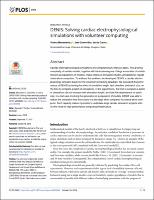Por favor, use este identificador para citar o enlazar este ítem:
https://repositorio.usj.es/handle/123456789/268
Registro completo de metadatos
| Campo DC | Valor | Lengua/Idioma |
|---|---|---|
| dc.contributor.author | Monasterio, Violeta | - |
| dc.contributor.author | Castro Mur, J. | - |
| dc.contributor.author | Carro, Jesús | - |
| dc.date.accessioned | 2019-12-17T14:38:42Z | - |
| dc.date.available | 2019-12-17T14:38:42Z | - |
| dc.date.issued | 2018-10-16 | - |
| dc.identifier.citation | Monasterio V, Castro-Mur J, Carro J (2018) DENIS: Solving cardiac electrophysiological simulations with volunteer computing. PLoS ONE 13(10): e0205568. https://doi.org/10.1371/journal.pone.0205568 | es_ES |
| dc.identifier.issn | 1932-6203 | es_ES |
| dc.identifier.uri | https://repositorio.usj.es/handle/123456789/268 | - |
| dc.description.abstract | Cardiac electrophysiological simulations are computationally intensive tasks. The growing complexity of cardiac models, together with the increasing use of large ensembles of models (known as populations of models), make extensive simulation studies unfeasible for regular stand-alone computers. To address this problem, we developed DENIS, a cardiac electrophysiology simulator based on the volunteer computing paradigm. We evaluated the performance of DENIS by testing the effect of simulation length, task deadline, and batch size, on the time to complete a batch of simulations. In the experiments, the time to complete a batch of simulations did not increase with simulation length, and had little dependence on batch size. In a test case involving the generation of a population of models, DENIS was able to reduce the simulation time from years to a few days when compared to a stand-alone computer. Such capacity makes it possible to undertake large cardiac simulation projects without the need for high performance computing infrastructure. | es_ES |
| dc.format.extent | 12 p. | es_ES |
| dc.format.mimetype | application/pdf | es_ES |
| dc.language.iso | eng | es_ES |
| dc.publisher | Alexander V. Panfilov, Universiteit Gent, BELGIUM | es_ES |
| dc.relation | This work was funded under project DPI2016-75458-R by MINECO and FEDER, by Aragon Government and European Regional Development Fund through Grupo de Referencia BSICoS (T39_17R), and by CIBER in Bioengineering, Biomaterials and Nanomedicine (CIBER-BBN) through the Instituto de Salud Carlos III and FEDER (Spain). The funders had no role in study design, data collection and analysis, decision to publish, or preparation of the manuscript. | es_ES |
| dc.relation.requires | Adobe PDF | es_ES |
| dc.rights | Atribución 4.0 Internacional | * |
| dc.rights.uri | http://creativecommons.org/licenses/by/4.0/ | * |
| dc.subject | Cellular electrophysiology | es_ES |
| dc.subject | Variability | es_ES |
| dc.subject | Equations | es_ES |
| dc.subject | Dynamics | es_ES |
| dc.subject | Models | es_ES |
| dc.title | DENIS: Solving cardiac electrophysiological simulations with volunteer computing | es_ES |
| dc.type | info:eu-repo/semantics/article | es_ES |
| dc.subject.unesco | Fisiología | es_ES |
| dc.relation.publisherversion | https://journals.plos.org/plosone/article?id=10.1371/journal.pone.0205568 | es_ES |
| dc.identifier.doi | https://doi.org/10.1371/journal.pone.0205568 | es_ES |
| dc.rights.accessrights | info:eu-repo/semantics/openAccess | es_ES |
| Aparece en las colecciones: | Artículos de revistas | |
Ficheros en este ítem:
| Fichero | Descripción | Tamaño | Formato | |
|---|---|---|---|---|
| journal.pone.0205568.pdf | 963,11 kB | Adobe PDF |  Visualizar/Abrir |
Este ítem está sujeto a una licencia Creative Commons Licencia Creative Commons

